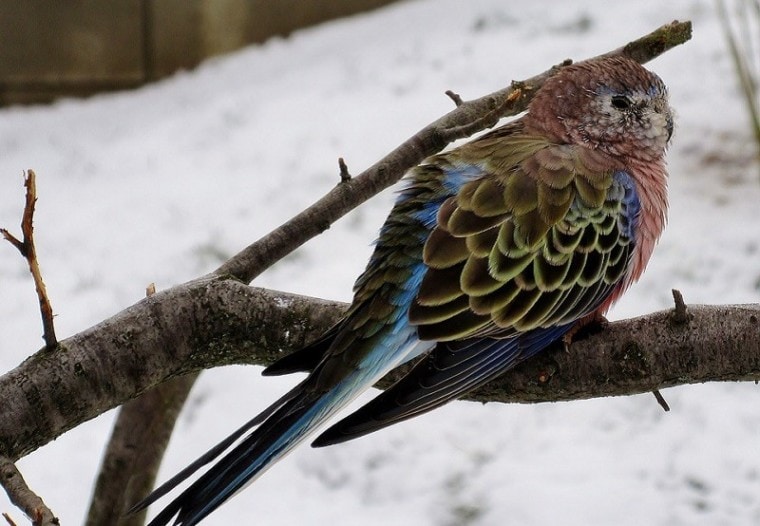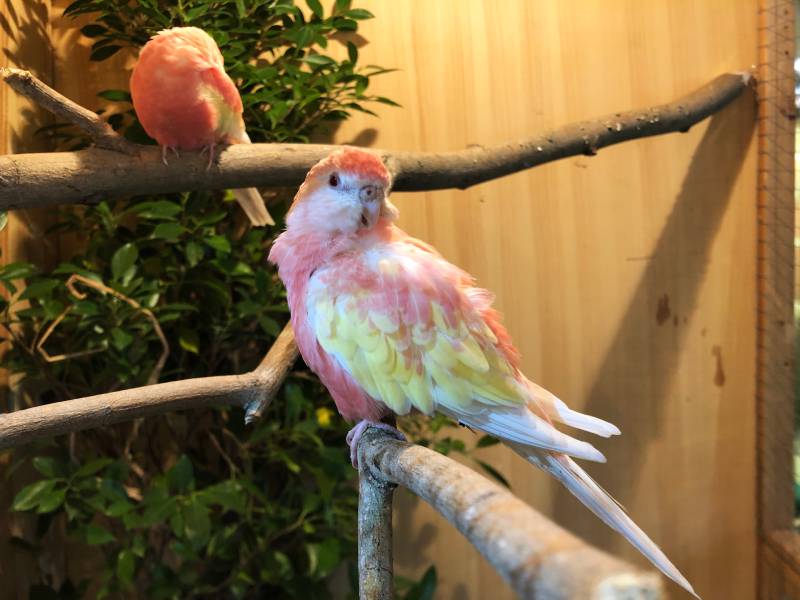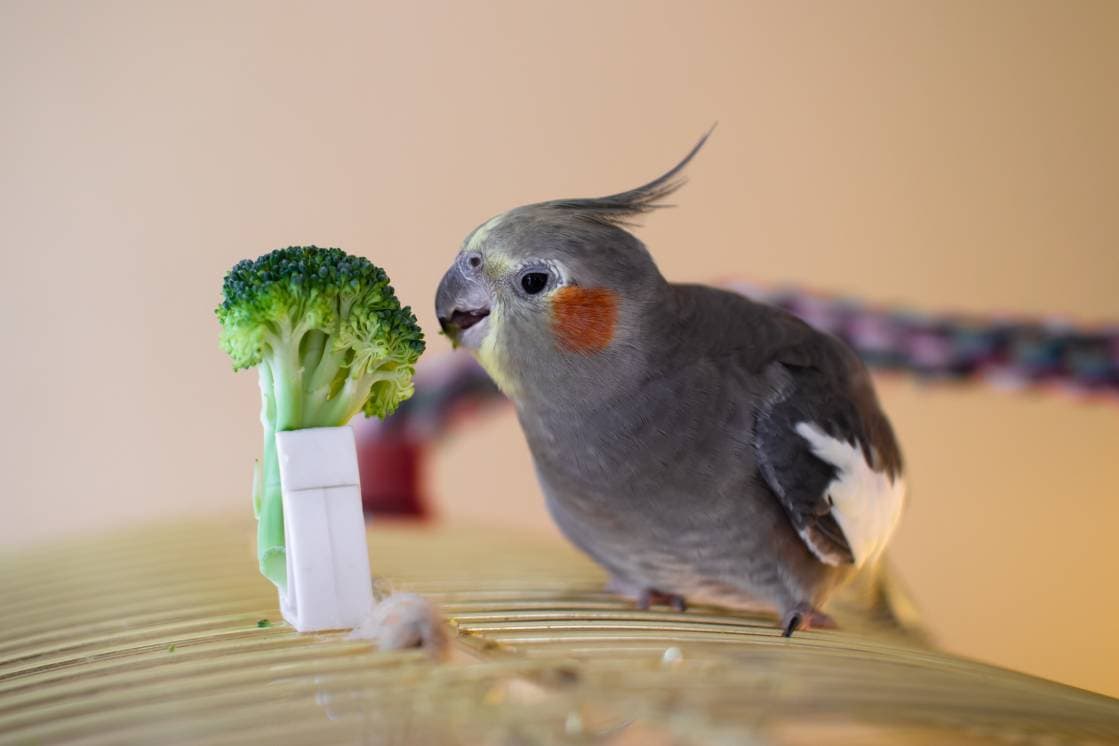
The Bourke’s Parakeet scores high marks on several scores. It’s an attractive bird with beautiful plumage. We also think that this bird is so darn cute with its white eyering. It is the only species of its genus, which makes it unique from a scientific point of view, too. Add its engaging personality, and you have a pet worth the hunt to find.
Species Overview

| Common Names: | Bourke’s Parakeet, Sundown Parrot |
| Scientific Name: | Neopsephotus bourkii |
| Adult Size: | 7 – 9 inches |
| Life Expectancy: | Up to 20 years |
Origin and History
The Bourke’s Parakeet lives in Australia, where it occupies a wide range in the country. You’ll typically see this bird in the shrublands and savannas of its native land, although it will also take to the trees. Its namesake is the former Governor of New South Wales, Sir Richard Bourke, who was instrumental in ending penal transport to the country in the 1800s.
English ornithologist, John Gould, described the species in 1841. Many consider Gould the father of bird study, thanks to his work in Australia and collaboration with Charles Darwin. The International Union for Conservation of Nature and Natural Resources (IUCN) lists the Bourke’s Parakeet as a species of least concern, with its numbers increasing in recent years.
Temperament

The Bourke’s Parakeet is a sweet bird that makes a delightful pet. It isn’t a loud species, which makes it a popular choice. These birds form monogamous relationships and are relatively easy to breed in captivity. They get along with other peaceful species in an aviary. The only time this parakeet gets territorial is during mating, which isn’t unusual.
The Bourke’s Parakeet rarely bites, which makes it an excellent choice for beginners. It has a calm disposition and will make an excellent choice for apartment dwellers who will appreciate this trait. They do best in a larger cage, which is especially true if you house it with other birds. The only other downside with this bird is that it is often active at dusk and dawn, making cage placement an issue to consider.
If you’re not pairing this bird, you’ll need to give your Bourke’s Parakeet a lot of attention. That’s the social nature of this species in action. They form smaller flocks, particularly when conditions are tough.
Speech & Vocalizations
If you’re looking for a bird that you can teach to talk, you might be disappointed. The Bourke’s Parakeet isn’t a talker in that sense. Remember that it’s not a vocal animal as far as parrots go. That may be a function of its environment, which is open. It doesn’t need to be loud to be heard. They may warble or whistle a bit, perhaps imitating you to some degree. Its calls are similar to budgies.
Bourke’s Parakeet Colors and Markings

As is often the case with many Australian birds, the Bourke’s Parakeet is colorful, which is one of its most powerful draws. As you may expect, the male is showier than the female. Pink adorns the breast and chest set against dark blue wing feathers that make the hues pop. Its rump and back are drab in comparison to its blue flanks. This bird has so much going on for it!
However, the colors are also understated, a nod to its docile personality. The females are not nearly as showy as the males. That’s a common scenario to avoid attracting predators. Unfortunately, that’s a problem with Bourke’s Parakeets and other native species. The culprit, in this case, is the non-native Red Fox causing the trouble.
Selective breeding has created other color variations, including rosy and Isabelle or tan with gray feathers. Feeding your parakeet a well-rounded diet can ensure the brightest colored plumage.
Caring for the Bourke’s Parakeet
Housing
The ideal cage for a Bourke’s Parakeet is three times its wingspan, making the recommended dimension for the width is 36 inches long (3 x 12 inches W). We recommend going with the biggest product you can get, especially if you have other birds with it. That will allow each one to have its space to prevent conflicts over perches or food.
The Bourke’s Parakeet loves to splash around in the water, perhaps a result of its sometimes arid native habitat. Make sure to provide a bowl for bathing and change the water frequently. In the wild, they will gather at watering holes. The bowl will replicate the setting for this instinctive behavior.
As with any pet bird, you should place your parakeet’s cage away from drafts or heat registers. You may find it helpful to cover your pet’s living quarters at night if it gets too loud during the dawn or evening. The Bourke’s Parakeet is an intelligent bird that will appreciate a cage filled with toys to keep your pet occupied.
Cage Mates
The Bourke’s Parakeet will do well with its Aussie mates, such as the Budgegiar and Cockatiel. It will also co-habit with finches. Mated pairs will keep to themselves and not cause any trouble with the other birds. Having several pets housed together can also prevent boredom while providing welcome mental stimulation.
Common Health Problems

The Bourke’s Parakeet is a relatively hardy bird, thanks to the adaptation to its harsh native habitat. They are relatively long-lived, which is a testament to their disease resistance. Proper cage placement and a healthy diet will go a long way toward keeping your pet free from these issues. Solitary birds are at a greater risk for boredom and feather plucking. Therefore, the active time is imperative if you only have one.
Diet and Nutrition
In the wild, the Bourke’s Parakeet forages both in the trees and on the ground. They eat a variety of seeds and grasses, with a special love for acacia. We suggest providing a varied diet to simulate what this bird would feed on in its native habitat. Seed mixes are an excellent choice to cover all the nutritional bases.
Exercise

Keeping your Bourke’s Parakeet in a flight cage will go a long way toward ensuring your pet gets enough exercise. Toys will provide the necessary mental stimulation. These birds aren’t as destructive as larger parrots, so you can take them outside of their living quarters to get a different view of their world. The time with you will benefit your parakeet immensely and make it a more enjoyable pet.
Where to Adopt or Buy a Bourke’s Parakeet
Bourke’s Parakeets are a popular species, so you probably won’t have a hard time finding one. They are easy to breed, which also helps. You can expect to pay under $100 unless you’re looking for a particular color variation. That can drive the price much higher. You’ll find them online. You might also be able to special order one from your local pet store.
We suggest getting a younger bird if possible, although the Bourke’s Parakeet is a docile animal by nature. It’s a wise plan whenever buying a parrot. It will help the bonding process and make it a more enjoyable pet. However, hand-raised birds will command a higher price, which is something to keep in mind.
Conclusion
The Bourke’s Parakeet ticks off so many boxes for an ideal pet. It is a gentle bird that is sociable for adding it to an aviary. It isn’t loud and isn’t aggressive. Its care is also easy-peasy, making it an excellent parrot for the first-time pet owner. They are also affordable and beautiful animals. What more can you ask?
Featured Image Credit: jggrz , Pixabay









